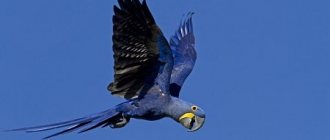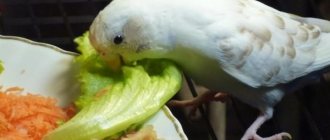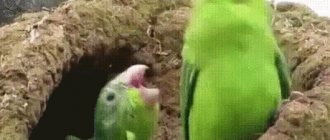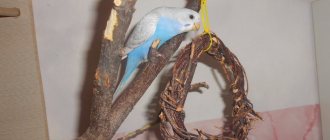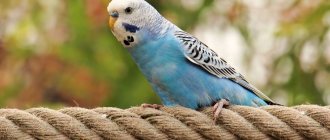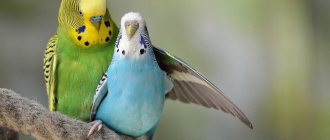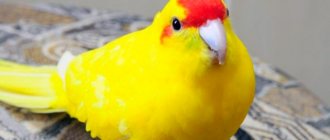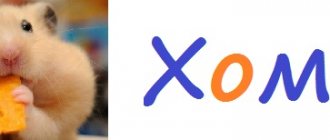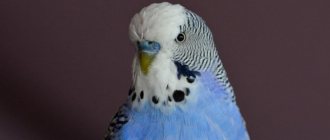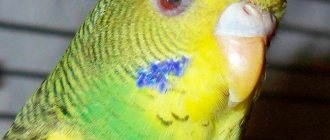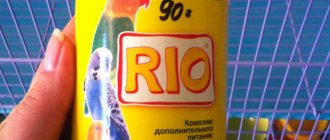Description
This species first appeared in England; one of the owners of the wavy birds had chicks that looked different from their parents. They had a completely different skull structure, the head was several times larger than that of representatives of the genus of budgerigars. Subsequent selection work with parrots allowed breeders to obtain a completely new breed; at the moment it is quite popular among parrot lovers and professional breeders who breed parrots for exhibitions and competitions.
How the breed was developed
The history of improving exhibition parrots began in England during the Second World War. Fleeing from the bombings, city residents moved en masse to the rural hinterlands, leaving their pets in city pet stores. In one of these, an unusual bird was first noticed, which aroused great delight and interest among the British, despite the difficult times.
How did the Czech parrot appear?
According to some reports, the breeder who left the birds received them from a pair of ordinary green voles. History says that he soon died without becoming famous during his lifetime. The breed of parrots he bred gave impetus to the creation of an English club, which subsequently dealt with the conservation and selection of this species. The Germans have achieved great success in obtaining various color variations of Czech wavy flowers.
The exhibition budgerigar was brought to the USSR from Czechoslovakia in the 80s of the last century, which is why it received the name that stuck to it - Czech.
The first exhibitions with the participation of noble birds in Russia were held only in 2011.
Read also
Food for budgerigars waka
Appearance
The body length of an adult parrot averages from 22 to 29 centimeters, which is one of the main differences from the wavy parrots. Thanks to active breeding work, you can purchase a parrot of almost any color. The most common colors are yellow, green, grey, lilac, blue and grey. You can also purchase a pet with several colors at once.
Purchase
It is not difficult to buy a regular budgie. They are sold in any pet stores and bird markets. Choosing a healthy Czech pet involves some difficulties:
- Unscrupulous breeders can slip an older bird, without a pedigree.
- The parrot may be in poor condition.
Following a number of recommendations will help you avoid such problems:
- The parrot must be inspected upon purchase. He must be curious and active. React to attention.
- All feathers must be in place. You should not pay attention to assurances that their absence is the result of molting. Most likely, the age of the bird does not correspond to the stated age.
- A healthy young Czech has a clear look, a well-groomed appearance, and the feathers are clean and not stuck together.
It is better to buy a purebred show parrot from a breeder or a registered club. This is an opportunity to purchase a healthy pet. You can also order a permanent ring, which will contain information about the club and the date of birth of the bird.
Spreading
The homeland of wavy fish is Australia. Parrots prefer to live in huge flocks, constantly wandering around the territory in search of food and water. Parrots fly very quickly, thanks to which they can fly vast distances in a short time. They prefer to stop on level places where they eat seeds. This genus of birds is very widespread throughout the continent; moreover, they are analogous to pigeons and sparrows in Europe. For breeding, they choose secluded places on the tops of trees.
Nutrition
In the wild, budgerigars eat mainly food of plant origin. One of their favorite delicacies is the seeds of various plants, as well as grains. They love to eat fruits, vegetables, berries, and grass. They sometimes feast on small insects and invertebrates.
At home, wavy fish are fed grain mixtures. It’s good if you have succulent food in your diet:
- nettle;
- dandelion;
- fresh carrots;
- apple;
- pumpkin.
Birds should receive mineral supplements - sepia, chalk. List of prohibited foods for parrots:
- candies;
- baked goods and bread;
- avocado;
- sausages;
- Red beetroot.
Behavior and character
Outwardly, Czechs look like real aristocrats and behave exactly the same. They have a calm character, they do not rush around the apartment screaming loudly. With all their appearance, Czechs show their beauty and importance. Most owners note the Czechs' penchant for communication, attention from the owner and love for games. Thanks to their extraordinary intelligence, they can remember human speech. With proper training, they can learn to carry out simple commands, assemble small pyramids and carry objects.
For a parrot to memorize human speech, you do not need to specifically train them.
Some birds independently reproduced sounds they had heard earlier. To train your pet, you should train it daily. Any birds are not the most patient students, so 15 minute lessons will be enough for them to start with, then they can be extended to 40 minutes.
Education, training, games
The bird cannot be alone; it needs to constantly find something to do.
In the absence of household members, he will entertain himself with the offered toys that are in the cage. To prevent the parrot from getting bored, hang a mirror in a safe frame.
A pet can be taught not only words, but also various tricks and games. He will immediately understand what is required of him when they offer to play hide and seek, catch a ball, or tug of war.
The wavy Czech will carefully watch how a person assembles and disassembles the pyramid and will be able to assemble it according to the same principle. Particularly persistent bird owners teach them how to add dominoes on an abacus. A bird must have only one teacher, otherwise the bird will get confused. Classes are initially given for 15 minutes, then the time is increased to 20, 30 and 40 minutes a day.
Differences from wavy
Czechs are bred from budgerigars, however, they differ quite significantly from their ancestors. The main differences are as follows:
- The size of Czechs is at least one and a half times larger than their relative.
- There are feather caps on the head.
- There are spots of different colors on the chest. Their size is larger than that of budgerigars.
- This breed is less active than the Wavys. They prefer a calm, unhurried gait to running; they can fly for a short time.
- On average, they have a calmer character. There are particularly active individuals that delight the owner with their squealing and active behavior.
- The bird's wings lie on the sides, and do not intersect on the back.
- One of the biggest differences is the cost of the chick. For professional breeders, the price quite often crosses the 10,000 ruble mark. In nurseries the price may be even higher, but such a bird will be able to take part in exhibitions.
Features of the Czech parrot
Appearance
The exhibition budgerigar has a courageous, proud appearance. He holds himself straight and straight, like a crowned lady. Let's take a closer look at the standard of this breed.
Features of the appearance of a parrot
- The wings fit tightly to the body, close at the sacrum without crossing. Each one does not exceed 12 cm in length and has seven flight feathers.
- The bird is strongly built, has broad shoulders and a massive short neck. The body looks like an elongated drop, reaches 23-29 cm in length and is inclined to the horizon at 60 degrees.
- The chest protrudes forward, which is why the bird has an even, natural posture.
- The long tail ends in two well-developed tail feathers.
- Legs are straight and strong. They have two oppositely directed pairs of fingers ending in claws.
- The large head has a high, powerful forehead, forming a smooth arc from the base of the beak to the back of the head.
- The eyes are expressive and may be slightly hidden under the feathers of a fluffy cap.
- The beak is firmly set.
- Single-color plumage on the front of the head.
- In the standard color, the neck marks on the bushy beard are bright, perfectly round, and symmetrically located. They form beads characteristic of the Czechs. There are three of them on each side, the outer ones are partially covered by elongated zygomatic spots.
- The color matches the color scheme of the described parrot. The plumage pattern is clean, clear, and well defined. The color is uniform, without unnecessary shades.
Read also
How to determine the age of a cockatiel parrot
Character and behavior
Czechs have a calm, friendly disposition. They sing less, but due to their perseverance, they are better able to learn spoken language. In the morning, this pet will not make loud noise, but will wait for the owner to wake up.
Parrot behavior and character
Having a massive build, this species of birds gets tired faster in flight and moves sedately and leisurely. Although, due to their individual character, there are also active, mischievous individuals.
Since parents often abandon their chicks, they are hand-fed by breeders. Therefore, most Czechs are very affectionate and make good contact with people. The life expectancy of parrots with proper care is about 13-15 years.
Read also
Habits of budgerigars
Smart Features
The bird likes communication and attention. The calm character makes the show wavy an attentive student. It reproduces not only individual words, but also entire phrases. Children often get a feathered companion, because Czechs are well trained and love to play. A one-year-old animal, with proper upbringing, is capable of folding a pyramid, sorting small objects, and following commands.
Content
The difference between the content of wavy and Czechs is small. The second ones are a little more unpretentious. The basic requirements for birds are as follows:
- The room should have a comfortable temperature above 20 degrees Celsius.
- The length of daylight hours should be from 10 to 13 hours.
- Certain conditions for air humidity.
- Constant communication with the owner. If this is not possible, it is better to get several birds that will communicate with each other.
Cell
The size of a suitable cage for a bird is 30*40*50 cm. This space is quite enough for one Czech; for several pets it is better to increase the size by 2-3 times. The best option for a family of parrots is an aviary. Inside you need to put several toys, a house for nesting (reproduction), drinking bowls, perches and feeders.
Czechs are a breed that was developed after crossing relatives' birds, which is why the birds' health is quite poor. The immune system has difficulty coping with even the simplest diseases. To protect your pet from diseases, the cage must be cleaned daily, morning and evening. 2-3 times a week it is necessary to disinfect drinking bowls and feeders.
Nutrition
It is better to place several feeders in the cage, each of which will contain different food. Grain is usually poured into one, mineral fertilizer into the other, and vegetables and fruits into the third. They can also be hung on the cage using holders.
The majority of the diet should be grains. Birds love millet most of all; in addition, you can add flax, oats and wheat. In general, one teaspoon of grains per day is sufficient. You can also supplement your diet with herbs, cottage cheese, boiled eggs, cereals and vitamins.
Care
All that Czechs require is proper care and constant contact with the owner or other birds. The first most important condition is the air temperature in the room. Parrots feel comfortable at temperatures from 20 to 25 degrees Celsius. Temperatures below 18 degrees are already critical for birds; the time of year is not important. It is also important to ensure that there are no drafts in the room.
The length of daylight hours is very important for Czechs, since in captivity they spend a lot of time in the sun. Moreover, the duration directly depends on the season of the year. In summer, the required duration is about 15 hours, in cold months - up to 10. The best option is, if possible, to take the cage outside (at a fairly warm temperature of hot air) for the whole day.
It is better to install an artificial color source indoors; a pet store can suggest a suitable lamp; you can also contact the breeder from whom you purchased the pet.
It is also necessary to perform a number of bird care procedures, including the following:
- Cleaning the cage or enclosure in which the bird lives. This must be done twice a day, morning and evening.
- The water in the drinking bowl must be changed every day; the parrot will not drink slightly stagnant liquid.
- It is also necessary to change the food in the feeders daily - constantly add fresh grain or mineral supplements, as well as change fruits and vegetables.
- The parrot must also be allowed to walk around the premises. A short flight walk once a day is enough.
- Parrots wash themselves enough; a bath day can be arranged once a week.
Owner reviews
The owners of Czech parrots speak only positively about them.
For my birthday I was given a Czech wavy. At first it seemed strange to me, since it was different in appearance from an ordinary wavy, but then I appreciated its beauty. Literally after a few months he began to repeat simple words, although I studied with him very rarely. The bird loves to communicate and is also quiet at night.
Anastasia
I specifically chose a Czech parrot for myself because I wanted to teach the bird to speak. My Gosha is very smart, as he easily remembers even complex words and entire phrases. All my friends and acquaintances admire him, and he has become a true friend to me.
Sergey
I chose the Czech parrot because of its unusual appearance. I didn't expect this bird to be so friendly and sociable. She spends time on my shoulder all the time at home and also loves it when I stroke her feathers. The only drawback is that Krosh often gets sick, so I often have to consult an ornithologist.
Christina
Diseases
Due to the poor health of the birds, Czechs quite often suffer from mycosis or dysbacteriosis. There are also parasites or worms, as well as viral or bacterial diseases.
Not a single bird is protected from illnesses, despite proper care and maintenance.
When the first signs of disease appear, you should immediately go to the veterinarian. It is strongly not recommended to treat your pet yourself; in the end, you can only make the parrot worse. It is necessary to carry out the following procedures daily to ensure that the bird is always healthy:
- Clean the parrot's place of residence.
- Closely monitor the health, activity and plumage of your pet.
- Place only fresh and clean vegetables and fruits in the feeder.
- Add mineral and vitamin supplements to food.
Arrangement of the cage
Compared to ordinary budgerigars, Czech parrots are large in size, so they need a large cage. It should have a minimum size of 30x40x50 cm. Such a cage is only suitable for one bird, but if there is free space, it is important to equip an aviary. It can be used for breeding Czech parrots.
Perches, perches, feeders, drinkers and toys are installed inside the cage. If you plan to keep a pair, you can install a nest designed for nesting.
If you keep a bird in a cramped cage, this can lead to infections and diseases. Czechs have reduced immunity, so it is important to monitor cleanliness. It is advisable to clean the inside of the cage twice a day, and the containers are disinfected before use.
It is also useful to read: Cage for a budgie
Price
The main difference between wavy fish and their descendants is the possibility of acquisition and cost. The former can be purchased at any pet store, and the latter only in specialized nurseries or from professional breeders. It is very important to purchase a pet on whose leg there is the age of the bird, a specific number and information about the place of purchase.
The ring guarantees the owner that his pet was bred by professionals, she is young and will live next to her owner for many happy years. Without it, it will not be possible to form a pedigree and, as a result, perform at exhibitions. In addition, such parrots have many times fewer offspring than unbanded birds. For this reason, and also because of the small number of chicks born, the cost of a young individual can reach 20,000 rubles.
Do birds get sick?
This breed has weak immunity, which leads to the birds getting sick quite often. They usually suffer from the common cold, so they should not be kept in drafty areas.
Czech parrots often get sick from dysbacteriosis and mycoses. They are vulnerable to worms and ectoparasites, represented by ticks or lice eaters. They often become infected with bacterial and viral infections.
If symptoms of any disease appear, you should promptly contact ornithologists. It is forbidden to engage in self-treatment, as this can lead to the death of the bird. Often, novice owners use the wrong medications or choose the wrong dosage.
To prevent serious illnesses, you can use simple preventive measures.
These include:
- timely and frequent cell cleansing;
- the use of disinfectants that treat all elements inside the cell;
- thorough washing of products that are offered to the wavy;
- inclusion of vitamin and mineral complexes in the diet.
Sometimes diseases and problems arise due to stress, so you need to keep birds only under calm conditions. It is recommended not to shout loudly or frighten the birds, and to ensure optimal rest at night.

